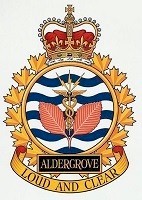|
HMC NRS ALDERGROVE
CFS ALDERGROVE
Naval Radio Station
There has been only one establishment named ALDERGROVE in the Royal Canadian Navy.
During the early years of the Second World War naval radio communications on the Pacific coast were handled by a radio station in His Majesty’s Canadian Dockyard, Esquimalt, British Columbia. As the base grew in size and complexity its unsuitability as a site for a radio communications station became increasingly apparent; interference from the base created a problem for receiving radio signals. In 1942, it was decided to build new stations, locating the Radio Receiving Station at Aldergrove, British Columbia, and the Transmitting Station near Matsqui village. The first buildings at ALDERGROVE were not ready for occupancy until more than a year later. Throughout the remainder of the war, ALDERGROVE handled the great bulk of naval communications traffic and continued to grow in size and add ever more modern equipment.
After the war the station continued to function as the naval communications centre for the Pacific Command, though it suffered, as did all Royal Canadian Navy (RCN) ships and establishments, from the acute manpower and money shortages of those years. With the growth of the RCN, which began in the early 1950’s following the outbreak of hostilities in Korea, ALDERGROVE also began to grow and many new buildings were added to accommodate the increased company.
On 1 June 1955, a change in administrative arrangements was made and the establishment was commissioned Her Majesty’s Canadian (HMC) Naval Radio Station ALDERGROVE. On 1 July 1956, the station finally became Her Majesty’s Canadian Ship ALDERGROVE. This change was made largely for morale purposes, as the commissioning of the station made possible the issue of an official ship’s badge and the wearing of a named cap tally on the sailors’ headdress. A badge with a gold rim and white and blue wavy striped background. A gold caduceus is in the centre of the badge, accompanied by two orange leaves to the right and left of it.
As a result of unification, HMCS ALDERGROVE was again re-named Canadian Forces Station (CFS) ALDERGROVE in 1967 and manned by members of all three elements. Its role was to maintain continuous communications with maritime authorities at sea and in the air, and to relay traffic to and from shore authorities. It was responsible to Maritime Command Pacific and was also part of the Commonwealth Worldwide Radio Organization. Downsizing and automation in the mid-1990s led to the facility becoming an attachment of Canadian Forces Base Esquimalt, rather than an independent Canadian Forces Station. The detachment was renamed Naval Radio Section ALDERGROVE in 1996 to officially acknowledge the unit's naval heritage. The transmitter and receiver sites are still staffed with technicians who perform routine maintenance and repair equipment failures. (Source: RCN Official Website)
The Badge of HMCS ALDERGROVE - BLAZON: Barry wavy of ten Argent and Azure. A Caduceus from the head of which issue three Forks of lighting to the dexter, entre And sinister chief respectively, Or, between the Alder leaves conjoining on one stem Gules. Significant: : The Caduceus is the attribute Of Hermes of Greek mythology, who was the Messenger or herald of the gods. It is used here As a symbol of one who carries, sends or receives Messages. The fact that these particular messages Are transmitted by means of radio is indicated by The three flashes of lightning that shoots out from The head of the Caduceus. THE NAME: ALDERGROVE is referred to by displaying sprig Of two alder leaves, these are shown red because the Particular kind of red alder that grows in the area where This station is located
Photos and Documents
P1RT George (Cowboy) Watt at Matsqui, HMCS ALDERGROVE'S transmitter site, 1972 From the collection of George Watt Courtesy of Christopher Watt
HMCS ALDERGROVE 1946 Softball Team From the collection of MS B. Anderson / William B. Clark Courtesy of Suzanne Clark
|





